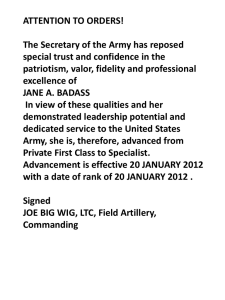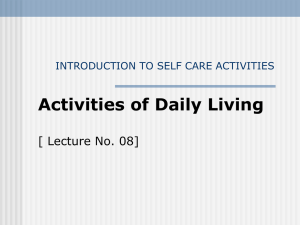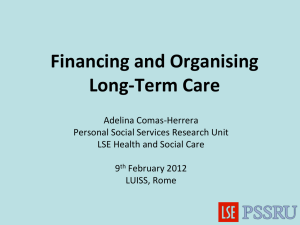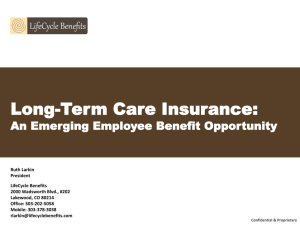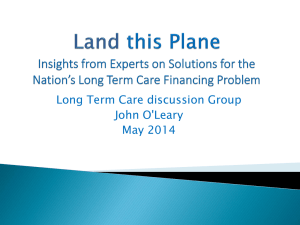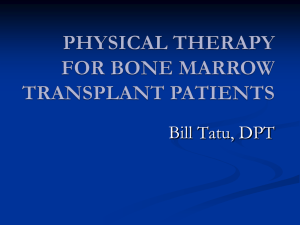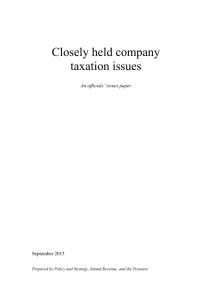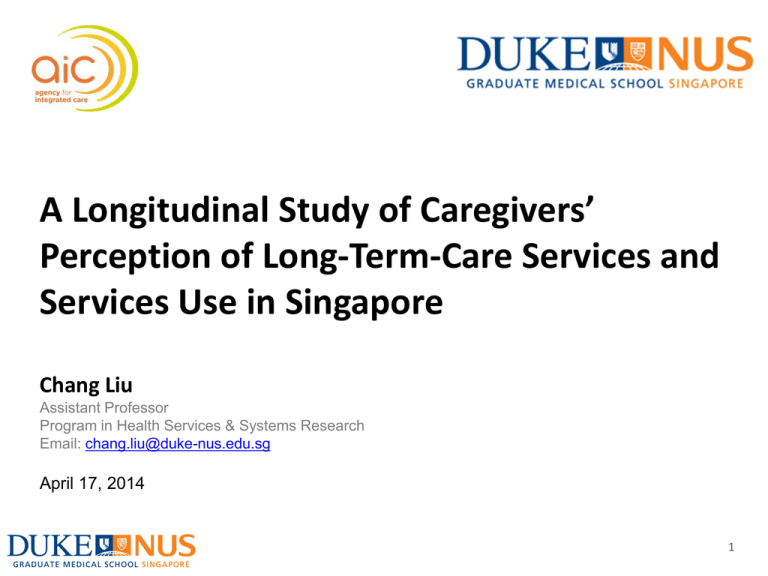
A Longitudinal Study of Caregivers’
Perception of Long-Term-Care Services and
Services Use in Singapore
Chang Liu
Assistant Professor
Program in Health Services & Systems Research
Email: chang.liu@duke-nus.edu.sg
April 17, 2014
1
Demographic Challenges
• Lower fertility
• Increased
longevity
• Later marriage
• Higher rate of
non-marriage
and divorce
Source: World Population Prospects: The 2010 Revision, http://esa.un.org/unpd/wpp/index.htm
2
Demographic Challenges
• The number and
proportion of
highly disabled
elderlies are
rising.
50,000
45,000
40,000
Persons
35,000
30,000
5-7 ADL limitations
25,000
20,000
1-2 ADL limitations
15,000
10,000
3-4 ADL limitations
5,000
0
2010
2015
Source: Ansah JP, Matchar DB, Love SR, et al. 2013.
2020
2025
2030
Year
3
Demographic Challenges
7
6
5
Children
• The number and
proportion of
highly disabled
elderlies are
rising.
• Family are
getting smaller
4
3
1-2 ADL limitations
2
1
2011
2014
2017
Age 60
2020
Year
Age 70
Source: Ansah JP, Matchar DB, Love SR, et al. 2013.
2023
2026
2029
Age 80
4
Demographic Challenges
• The number and
proportion of
highly disabled
elderlies are
rising.
• Family are
getting smaller
• More caregivers
will have
significant
depression
attributable to
caregiving
12000
10000
8000
6000
4000
2000
Individuals with depression
attributable to caregiving
1-2 ADL limitations
Individuals with depression
irrespective of caregiving
0
2010 2011 2012 2013 2014 2015 2016 2017 2018 2019 2020 2021 2022 2023 2024 2025 2026 2027 2028 2029 2030
Source: Malhotra C, Malhotra R, Østbye T,,et al. 2012.
5
How much can the system handle?
Temporary beds in
air-conditioned tent
@ Changi General
Source: Straits Times.
6
A framework for addressing the
challenges
Self-care
Enhanced
Community
services
Family
Medical
General
Clinic
Practitioner
Polyclinic
Specialty
Outpatient
Clinic
Acute
Hospital
Service
integration
Transitional
care
Agency for Integrated Care (AIC)
7
Long-Term Care Services Use
• Governmental investments on formal Long-term Care Services (LTCS)
– Provide higher subsidy in 2012
– Invest S$ 500 million on eldercare facilities from 2013-16
– Add 3000+ NH beds by 20161
– Planned to increase NH beds by 70% by 2020 – from 9,000 today to 15,600 1
• LTCS utilization is low compared to Western societies2
– AIC: take-up rate for some community services is less than 50%
• Should we promote take-up LTCS given that:
– Limited information and awareness of the services
– LTCS can be cost-effective for the society3
Source: 1. William Haseltine, Affordable Excellence: the Singapore Healthcare Story, 2013.
2. Koh GC-H, et al, 2012; Wee, Liu et al. 2014.
3. Khiaocharoen et al, 2012; Saka et al, 2009; Yuan et al, 2014
8
Main Research Questions
• What are the factors associated with the take-up of formal LTCS?
And whether they differ across different LTCS?
• Are there some sub-groups of population with extremely low
utilization rates (outliners)?
•
What are the potential ways to improve take-up of LTCS? Can we
increase the take-up rate by impacting the caregiver’s perception
on services?
9
Previous Studies
The Andersen Model of Health Care Utilization1
• Does not consider caregiver (CG) characteristics, which are important in
the Asian context.
– Care recipients (CR) for LTCS have higher dependent level
– CG and CR are more likely to live together
– Social norm
• Does not account for their awareness and perception about the services2
• With limited empirical studies in Asia: Hong Kong (2009), Japan (2011)3
Source: 1. RM Andersen. J Health Social Behavior 1995; 36:1-10.
2. Ching AT et al, 2010; Gneezy U, et al, 2011; Crawford GS, et al, 2005.
3. Lou et al, 2011; Murayama et al, 2011.
10
AIC LTC Referral Study:
Survey and Data
• A Longitudinal study
– Dyads of care recipients and their caregivers
– Three waves over a 12 month period
• Gathered information on both CR and CG: demographic, health status,
financial resources, living arrangement, knowledge and awareness, etc.
• Two measures of LTCS utilization:
1) whether took-up the referral
2) current LTC services use (a choice of nursing home, center-based services,
home-based services, family and friends, maid).
• CG’s perception/rating of formal and informal LTCS: quality, convenience,
social connectedness, and affordability (score range from 1-5).
11
AIC LTC Referral Study:
Survey and Data
• Stratified sampling by:
1)
2)
Service types - Day Rehabilitation, Dementia Day Care, Home Medical,
Home Nursing, Home Therapy, and Nursing Home
Socio-economic characteristics – Seven Mosaic Singapore groups*
• Response rate : 43%
• First wave analytic sample: 1586 dyads
553 care recipients, 1027 proxies and 1502 caregivers
Note: Mosaic Singapore is a geo-demographic consumer segmentation system, developed based on more than 20 years of segmentation
development expertise. It classifies all Singapore households and neighborhoods into 7 groupings that share similar demographic and socioeconomic characteristics. It paints a rich picture of Singapore consumers in terms of their socio-demographics, lifestyles, culture and behaviors.
12
CR Baseline Characteristics
Variable (%)
Age:
<=64
65-74
>=75
Female
Married
Education:
None
Primary
Secondary+
Household Income:
<500
500-1999
2000+
Don’t know/refuse
Comorbidity:
0-1
2-4
5+
ADL Score:
Low
Medium
High
Any Community
LTC Services
(n=1,416)
Center-Based
LTC Services
(n=792)
Home-Based
LTC Services
(n=624)
22.4
24.9
52.8
55.9
50.5
23.2
26.5
50.3
55.9
53.3
21.3
22.8
55.9
55.9
47.0
41.7
30.1
28.3
37.2
31.7
31.1
47.3
28.0
24.7
38.8
27.4
15.1
18.6
35.0
31.6
15.7
17.8
43.8
22.1
14.4
19.7
18.8
50.1
31.1
17.7
52.2
30.2
20.2
47.6
32.2
38.1
31.8
30.2
48.7
37.5
13.8
24.5
24.5
51.0
P-Value
0.096
0.999
0.020
0.001
0.000
0.000
0.000
13
Take-up of Referred LTC Services
14
Approaches
• Dependent variables:
1) whether took-up the referral
2) current LTC services use (a choice of nursing home, center-based services,
home-based services, family and friends, maid).
• Independent variables: CG’s perception score on quality, convenience, social
connectedness, and affordability (score range from 1-5).
• Covariates: CR’s age, sex, housing, education, comorbidity, ADL, iADL, income,
Medisave status, and CG’s age, sex, housing, health, # of family members in the
household, decision, and whether or not they have a maid.
•
•
Statistical methods:
1)
Logistic Regression
2)
Conditional Logistic Regression
Two waves data: repeated cross-sectional and longitudinal analysis
15
Perception Scores and Take-up
Referred LTCS
Odds Ratio of Referred LTC Service Utilization [95% CI]
Any LTC Services
Wave 1 + Wave 2
Quality Score
Convenience Score
Social Connectedness Score
Affordability Score
Center-Based Services Home-Based Services
N=1,795
N=875
N=650
1.27**
[1.08, 1.48]
1.24**
[1.09, 1.41]
1.07
[0.94, 1.21]
1.34***
[1.20, 1.49]
1.34*
[1.06, 1.70]
1.31*
[1.08, 1.60]
1.21
[0.99, 1.48]
1.40***
[1.18, 1.66]
1.18
[0.89, 1.15]
1.22
[0.96, 1.54]
0.92
[0.75, 1.13]
1.42***
[1.19, 1.69]
Adjusted for care recipients’ age, sex, housing, education, comorbidity, ADL, iADL, income, Medisave status, and care
givers’ age, sex, housing, health, # of family members in the household, decision, and whether or not they have a
maid. *p<.05 **p<0.01 ***p<0.001
16
Perception Scores and Take-up
Referred LTCS
Odds Ratio of Referred LTC Service Utilization [95% CI]
Any LTC Services
Wave 1 on Wave 2
Quality Score
Convenience Score
Social Connectedness Score
Affordability Score
Center-Based Services Home-Based Services
N=782
N=406
N=264
1.19
[0.94, 1.51]
0.98
[0.80, 1.20]
1.11
[0.90, 1.37]
1.21*
[1.03, 1.42]
1.12
[0.77, 1.63]
1.25
[0.91, 1.73]
1.22
[0.89, 1.67]
1.34*
[1.04, 1.74]
1.32
[0.81, 2.15]
0.70
[0.44, 1.10]
1.50
[0.97, 2.32]
1.05
[0.77, 1.42]
Adjusted for care recipients’ age, sex, housing, education, comorbidity, ADL, iADL, income, Medisave status, and care
givers’ age, sex, housing, health, # of family members in the household, decision, and whether or not they have a
maid. *p<.05 **p<0.01 ***p<0.001
17
Perception Scores and
Current Service Utilization
Odds Ratio of Current LTC Service Utilization [95% CI]
Model 1
Model 2
Wave 1 + Wave 2
N=5,996
N=3,180
Quality Score
1.18*
[1.03, 1.34]
1.14
[0.93, 1.39]
1.17*
[1.04, 1.32]
1.07
[0.96, 1.20]
1.29***
[1.18, 1.42]
1.19
[0.99, 1.43]
0.96
[0.82, 1.13]
1.39***
[1.21, 1.61]
Convenience Score
Social Connectedness Score
Affordability Score
In these conditional logistic models, each patient becomes 5 observations, each stands for one type of current
LTC services: community-based, home-based, nursing home, family and friends, and maid.
In model 1 we only adjusted for whether referred service type; in model 2, we, in addition, adjusted for care
recipients’ ADL and iADL. *p<.05 **p<0.01 ***p<0.001
18
Top Reasons for Withdrawal/Rejection
of Referred Service
19
Household Income and Affordability
20
Next Steps
• Examine effect of use/non-use on subsequent health status, other service
use and quality of life
• System modeling the demand of formal LTCS for lower income, moderate
to high ADL population
• Design a randomized controlled trial (RCT) to improve the uptake of and
adherence to outpatient rehabilitation service among stroke patients
21
Collaborators
Agency for Integrated Care (AIC)
• Wee Shiou Liang
• Wayne Chong
Changi Hospital
• Goh Soon Noi
Duke-NUS
• Kirsten Eom
• Angelique Chan
• Amudha Aravindhan
• Tian Yuan
• David Matchar
22
“Health economics (health services and systems
research) can be intellectually stimulating, socially
useful, and personally rewarding.”
- Victor R. Fuchs
Thank You!
23
A Longitudinal Study of Caregivers’
Perception of Long-Term-Care Services and
Services Use in Singapore
Chang Liu
Assistant Professor
Program in Health Services & Systems Research
Email: chang.liu@duke-nus.edu.sg
April 17, 2014
24
Referred vs. Current Services
Referred Services
100%
Current Primary LTC Service
90%
80%
70%
60%
50%
40%
30%
20%
10%
0%
Community-Based Services
Home-Based Services
Nursing Home
None
163
113
9
Maid
86
73
0
Family and Friends
72
48
7
Nursing Home
2
9
152
Home-Based Services
1
337
1
426
3
0
Community-Based Services
25



